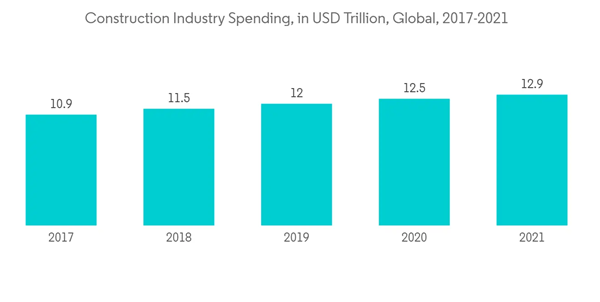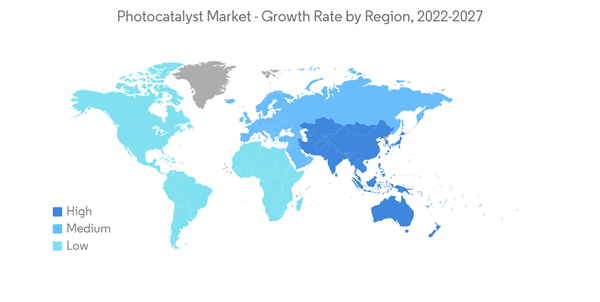The Photocatalyst Market size is estimated at USD 2.70 billion in 2024, and is expected to reach USD 4.29 billion by 2029, growing at a CAGR of 9.68% during the forecast period (2024-2029).
The COVID-19 pandemic had a negative impact on the market for photocatalysts. Currently, the market has recovered from the pandemic and growing at a significant rate.
This product will be delivered within 2 business days.
The COVID-19 pandemic had a negative impact on the market for photocatalysts. Currently, the market has recovered from the pandemic and growing at a significant rate.
Key Highlights
- Over the short term, high demand for titanium dioxide and increasing water treatment and air purification applications are likely to drive the demand for the photocatalyst market.
- However, high capital investments are expected to hinder the growth of the market.
- Nevertheless, increasing research and development as a disinfectant is expected to generate attractive market growth and give substantial potential in the forecast period.
- The Asia-Pacific region is expected to dominate the global market, with the majority of the consumption coming from China and India.
Photocatalyst Market Trends
Increasing Demand from Self Cleaning Application
- Photocatalytic self-cleaning is probably the most widely used nano-function in building construction. Numerous buildings around the world make use of this function. Its primary effect is that it greatly reduces the extent of dirt adhesion on surfaces. Another advantage is that light transmission for glazing and translucent membranes is improved since surface dirt and obscure grime sunshine are less, which can reduce lighting energy costs.
- Photocatalytic paints and coatings have been developed in recent years to coat the outer surface and interiors of the building. Photocatalytic coatings not only wash off dirt but also break down contaminants and stains: airborne pollutants, and smog from the exterior surfaces of the building. Furthermore, photocatalyst coatings remove odors and break down VOC, airborne viruses, and bacteria from the interior furniture of the building. Moreover, photocatalyst coating is one of the major options preferred to protect wooden surfaces in the interior of the building.
- The application of photocatalytic material is not limited exclusively to large buildings. It can be equally appropriate, for example, for conservatories and winter gardens. In road building, the transparent coating can also be used, for example, for noise barriers. Tiles with baked-on durable coatings are available for use both indoors and outdoors. Likewise, concrete, another common building material for facades, can also be equipped with a self-cleaning surface. Hence the construction sector will contribute majorly to the demand for self-cleaning photocatalytic materials in the forecast period.
- The global construction industry is growing at a healthy rate. Asia-Pacific, along with the Middle East and African regions, is witnessing huge investments in the construction sector due to numerous market opportunities available in these markets.
- According to the National Bureau of Statistics of China, China's construction output value peaked in 2021 at roughly CNY 29.3 trillion (USD 4.2 trillion), compared to CNY 26.39 trillion (USD 3.79 trillion) in 2020.
- According to The Ministry of Land, Infrastructure, Transport, and Tourism (Japan), total construction investment in Japan was over JPY 66.6 trillion (~USD 498.10 million) in the fiscal year 2021, with building construction accounting for more than half of this expenditure. Total construction spending is expected to reach almost JPY 67 trillion (~USD 501.09 million) in the fiscal year 2022.
- In Europe, Germany has taken the lead in developments in the construction sector. Alexander Berlin's Capital Tower and Estrel Tower are some of the major high-rise buildings the country is developing at present. The construction sector is further rising in the country owing to significant investments in its infrastructural sector and further due to the rising demand for residential units.
- According to World Bank, the construction industry grew to a spending value of USD 12.9 trillion in 2021 and is expected to grow by three percent per annum. This comprises real estate developments, both residential and commercial, as well as infrastructural and industrial constructions. Data on construction spending cover labor and material costs, architectural and engineering work, and taxes.
- The self-cleaning photocatalytic coating is used to coat optically transparent glass materials, which are used in many applications, including automobile windshields, window glass, skyscrapers, microscopes, eyeglasses, solar cell panel covers, kitchen appliances, screens of many electronic devices, and optical instruments.
- The self-cleaning photocatalytic coating on low-cost, lightweight, and flexible PC substrates is crucial for multifunctional self-cleaning devices to be useful. Therefore, other end-user industries, such as automobile, electronics, medical, and solar energy generation, will also contribute significantly to the demand for self-cleaning photocatalytic material in the forecast period.
- All the aforementioned factors will contribute towards industry growth during the forecast period.
Asia-Pacific Region to Dominate the Market
- Asia-Pacific dominates the photocatalyst market in terms of market share and market revenue. The region is set to continue its dominance over the forecast period.
- The super-hydrophilic nature of photocatalysts imparts the self-cleaning nature. For instance, titanium dioxide provides a photocatalytic protective film, which possesses the property of self-cleaning by becoming super-oxidative and hydrophilic. This property of photocatalyst caters to its high-demand application as self-cleaning aid in paints and coatings. Moreover, as a photocatalyst, it transmits unique cleaning and anti-microbial properties. Hence, with the increasing construction activity, the demand for paint and coatings is expected to increase, which is driving the market demand for photocatalysts.
- The growing demand for paint and coatings due to the growing demand from construction, automotive, and packaging is expected to drive the market for photocatalysts during the forecast period. China produces around 30% of the total global paints and coatings, which is acting as a major source in the consumption of photocatalysts, owing to their self-cleaning properties when induced in paints and coatings.
- PPG Industries plans to construct its South Chinese R&D and production base by 2022, with an investment of CNY 620 million (USD 89.03 million). Asia Cuanon also signed an agreement to construct a new production base in Changsha, Hunan province, with a total investment of CNY 600 million (USD 86.16 million), which will include 200 thousand metric tons of high-quality architecture coatings and other construction materials.
- BASF Coatings (Guangdong) Co. Ltd has the only automotive refinish coatings production site for BASF in Asia. The company is constructing a new facility for automotive refinish coatings that have started production in the first half of 2022.
- According to the National Bureau of Statistics of China, China has grown to become the world's largest construction market. The value of China's construction industry was USD 1,117.42 billion in 2021. Since the government intends to focus on upgrading infrastructure in small and medium-sized communities, the construction industry is expected to increase at a five percent yearly rate.
- The paints and coatings industry in Japan was the second largest in Asia-Pacific, as it has well-established manufacturing bases in the automotive, chemicals, appliance, and electronic industries, which are the largest consumers of the paints and coatings industry.
- The production of paints and coatings in Japan is mainly driven by the growing demand from the construction and other industrial sectors. According to The Ministry of Land, Infrastructure, Transport, and Tourism (MLIT Japan), total construction investment in Japan was YPY 66.6 trillion (USD 499.03 million) in the fiscal year 2021, with building construction accounting for more than half of this expenditure. Total construction investment is expected to reach almost YPY 67 trillion (USD 502.03 million) in the fiscal year 2022.
- All such expansions in paint production with the growing demand in the country are further expected to drive the market demand for photocatalysts during the forecast period.
Photocatalyst Industry Overview
The photocatalyst market is consolidated in nature, with the top five players having major production capacities. Some of the key players are The Chemours Company, Tronox Holdings PLC, Venator Materials PLC, Lomon Billions, KRONOS Worldwide Inc., and others.Additional Benefits:
- The market estimate (ME) sheet in Excel format
- 3 months of analyst support
This product will be delivered within 2 business days.
Table of Contents
1 INTRODUCTION1.1 Study Assumptions
1.2 Scope of the Study
2 RESEARCH METHODOLOGY
3 EXECUTIVE SUMMARY
4 MARKET DYNAMICS
4.1 Drivers
4.1.1 Rapidly Growing Demand for Titanium dioxide
4.1.2 Increasing Applications in Water Treatment and Air Purification
4.2 Restraints
4.2.1 High Capital Investment
4.2.2 Other Restraints
4.3 Industry Value Chain Analysis
4.4 Porter Five Forces
4.4.1 Threat of New Entrants
4.4.2 Bargaining Power of Buyers
4.4.3 Bargaining Power of Suppliers
4.4.4 Threat of Substitute Products
4.4.5 Degree of Competition
5 MARKET SEGMENTATION
5.1 Type
5.1.1 Titanium dioxide
5.1.2 Zinc Oxide
5.1.3 Other Types
5.2 Application
5.2.1 Self-Cleaning
5.2.2 Air Purification
5.2.3 Water Treatment
5.2.4 Anti-Fogging
5.2.5 Other Applications
5.3 Geography
5.3.1 Asia-Pacific
5.3.1.1 China
5.3.1.2 India
5.3.1.3 Japan
5.3.1.4 South Korea
5.3.1.5 Rest of Asia-Pacific
5.3.2 North America
5.3.2.1 United States
5.3.2.2 Canada
5.3.2.3 Mexico
5.3.3 Europe
5.3.3.1 Germany
5.3.3.2 United Kingdom
5.3.3.3 France
5.3.3.4 Italy
5.3.3.5 Rest of Europe
5.3.4 South America
5.3.4.1 Brazil
5.3.4.2 Argentina
5.3.4.3 Rest of South America
5.3.5 Middle-East and Africa
5.3.5.1 Saudi Arabia
5.3.5.2 South Africa
5.3.5.3 Rest of Middle-East and Africa
6 COMPETITIVE LANDSCAPE
6.1 Mergers and Acquisitions, Joint Ventures, Collaborations, and Agreements
6.2 Market Share (%) **/ Ranking Analysis
6.3 Strategies Adopted by Leading Players
6.4 Company Profiles
6.4.1 Daicel Miraizu Ltd
6.4.2 Green Millennium
6.4.3 Hangzhou Harmony Chemical Co. Ltd
6.4.4 ISHIHARA SANGYO KAISHA Ltd
6.4.5 KRONOS Worldwide Inc.
6.4.6 Lomon Billions
6.4.7 Nanoptek Corp.
6.4.8 SHOWA DENKO KK
6.4.9 TAYCA
6.4.10 The Chemours Company
6.4.11 TitanPE Technologies Inc.
6.4.12 Tronox Holdings PLC
6.4.13 Venator Materials PLC
7 MARKET OPPORTUNITIES AND FUTURE TRENDS
7.1 Increasing Research and Development as a Disinfectant
Companies Mentioned (Partial List)
A selection of companies mentioned in this report includes, but is not limited to:
- Daicel Miraizu Ltd
- Green Millennium
- Hangzhou Harmony Chemical Co. Ltd
- ISHIHARA SANGYO KAISHA Ltd
- KRONOS Worldwide Inc.
- Lomon Billions
- Nanoptek Corp.
- SHOWA DENKO KK
- TAYCA
- The Chemours Company
- TitanPE Technologies Inc.
- Tronox Holdings PLC
- Venator Materials PLC
Methodology

LOADING...










